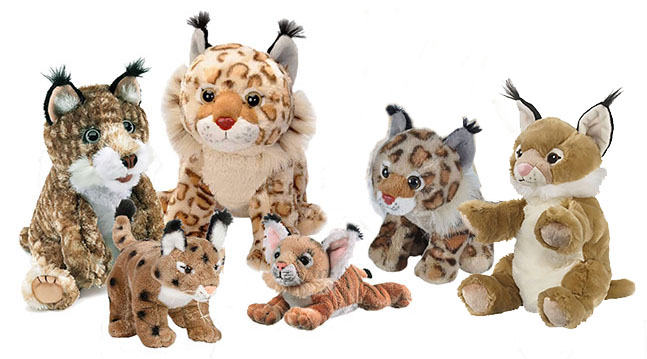

Bobcat Plush Toys and Gifts
Find bobcat stuffed animals and Lynx stuffed animals, plus facts and information at Animals N More.
These Bobcat stuffed animals include a Folkmanis Bobcat Kitten puppet and a little Bobcat stuffed animal from Rhode Island Novelty Plush in front of it. To the lower front is the Wildlife Artists Bobcat. There is a Wild Republic Cuddlekins Bobcat and a mini-cuddlekins bobcat. There is a Bobcat Hand Puppet from Wildlife Artists (right). We also carry some plush toy Lynx wildcats. Check our sponsor's online Gift Shop to see if there are any Bobcats or Lynx in stock.
The Bobcat (Lynx rufus) is the most common wildcat in North America. About the same size as the Lynx, this cat is on average 40 inches long. This tawny gray medium-size cat has a short, stubby tail that is tipped and barred with black. The Lynx is similar but with grayer fur and very pronounced black ear tufts.
The Bobcat gets its name from its "bobbed" tail. These cats are loners and only come together to mate during the months of February and March. There is one litter of from one to seven young. The gestation period is from 63 to 70 days. The young are weaned in two months and hunting on their own by Fall but stay with the mother for about one year.
There are anywhere from 700,000 to 1,500,00 bobcats living in North America.They live in a variety of habitats including woods, scrub, swamps, farms and cities. The prey includes rodents, rabbits and hares, but bobcats will also attack larger prey such as deer. The bobcat's only predator is man and the automobile, although bobcat young are hunted by foxes, owls and even adult male bobcats.
The lynx (Lynx lynx) is a
medium size light grey cat mottled with blackish brown hairs. It has a short tail tipped with black and black ear tufts. The male is larger than the female, about 40 inches long and 4 feet tall. These are solitary creatures, only coming together to mate.
These cats mate in the spring and the young are born between April and June. The gestation period is about 65 days. Kittens remain with their mother for the first winter. They are weaned at about three months.
The lynx's range is throughout much of Canada, Alaska and sparsely in the northern tier of the United States. It is adequately equipped for hunting in its range, large feet for swimming and stalking through snow, mostly going after the snowshoe hare, but also stalking birds and voles. The lynx will also eat the remains of the kill of other larger animals. It will climb trees and wait for passing prey to pounce upon.
Predators of the lynx are wolves, mountain lions and man.
These cats are generally silent but will shriek or scream during the mating season.




